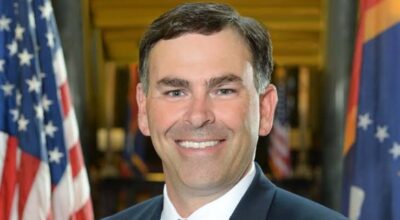Covid, floods, fire, and now Zeta – it’s 2020
Published 12:56 pm Thursday, November 5, 2020

By John Howell, Sr.
Publisher Emeritus
Zeta came along as a weird hurricane in the midst of a season of ever more weirding weather.
For Mississippi, Louisiana and their Gulf-facing neighbors it started in early June with Cristobal, now a tropical storm of distant memory. It made landfall near the mouth of the Mississippi but quickly weakened to a tropical depression. In July it was Hanna, which achieved Category 1 before making landfall near Padre Island, Texas.
Then August brought Laura, which had grown to Category 4 by the time it made landfall in southwest Louisiana near Cameron. Laura’s destruction was record-breaking by many measures but only the first round for its victims, many of whom were still housed in New Orleans hotels six weeks later when Category 2 Delta came ashore in Creole, LA, not far from Cameron.
And coinciding with Laura’s trip through the Gulf was meandering Marco which grew to Category 1 before petering out near the mouth of the Mississippi River where it was greeted mostly with a shrug. Not so Sally, which formed in September and achieved Category 2 strength but without steering winds, leaving it to its own devices. If you can picture a hurricane as a spinning gyroscope, it stays mostly in place as it spins, but if you blow it gently, it’ll move along in the direction its blown.
Sally had no such propulsion and meandered for several days south of the Mississippi, Alabama and Florida coasts. When it finally moved crawled ashore at Gulf Shores on September 16, it had had time to build up a huge storm surge. Moving so slowly, the quadrants of the hurricane that were still over the Gulf pulled out sea moisture and then deposited it as torrential rain as it moved inland.
There were a number of tropical weather systems in the Gulf and Atlantic that strengthened sufficiently to earn a name — Arthur, Dolly, Edouard, Gonzalo, Josephine, etc. — and then fizzled, thus consuming the entire list of the World Meteorological Organization’s 2020 storm names by mid-September, forcing us to the letters of the Greek alphabet. That brought us Beta, which came ashore as a tropical storm on the Eastern coast of Texas in mid-September.
Finally (not really, Eta has formed in the Caribbean but is forecast to come ashore in Central America) came Zeta.
From the earliest National Hurricane Center forecast, Zeta was zeroed in on southeast Louisiana and New Orleans. (Unlike Sally, the Zeta’s steering currents were forecastable from the start.) When it got here on Wednesday night it was moving forward at 25 miles per hour or more — faster than any others whose progress I have followed. It was moving so fast, it didn’t have time to drop much rain.
This was most fortunate for mostly-below-sea-level New Orleans, where the city’s storm water drainage depends on a pumping system now more than a century old and part of which is usually out of service when heavy rains threaten. Zeta was mainly a wind event that wrought havoc on the electrical infrastructure in Louisiana and Mississippi.
We felt the bands of wind (and the little rain that accompanied them) strengthening throughout Wednesday afternoon and lost power about 5 p.m. Wind gusts peaked about 6 p.m. I’ve no idea how high wind speeds got here (nearer the coast, gusts were clocked at 110 to 120 mph, but Uptown they were probably 70 to 80, max). A few minutes later Zeta’s calm eye passed through and winds calmed.
Everybody on our block came out on their front porches to take it in. People loosed their kids and gave them a few minutes to run across the street to the park and discharge pent up energy. It was surreal. We never saw clear sky as the eye passed over, but the sun setting behind thinned clouds gave us colors that artists love.
After about 20 minutes, the winds started picking back up but never regained their original strength. Shortly afterward, we heard a great tearing, crashing sound as the larger branches of a tree across the street were twisted from their trunk, partially blocking the roadway, but with no other consequence. The strength of the wind gusts soon diminished as Zeta hurried northeast into Mississippi. Zeta was a fast mover.
And it was dark. But not completely. Houses one block in either direction kept their power throughout. It was like that in many places — small islands of electric light in the midst of darkened neighborhoods. We were partially prepared with a small generator sufficient to keep the fridge running — also, as we discovered within a few days — the television with its rabbit-ears antenna. We cook with gas and the stove eyes remained operable as did our old hot water heater.
Hurricane aftermath usually includes hot, humid weather, but a welcomed fall cool front rode in with the storm, bringing down nighttime temps low enough to need heat, which was inoperable without electricity. Heat after a hurricane? Who’d have ever thunk it?
We played the guessing game of when our power would be restored until Sunday morning when it popped back on around 11:30. We’ll spend a few days cleaning up — mainly on the inside where the recently restored lights have exposed how messy we got during the darkness.
But we’re largely unscathed, unlike so many in this state and elsewhere who have been hit hard by this year’s storms, wildfires, COVID-19, unemployment, economic and social unrest — the list is long. And though Eta’s track takes it to land in Central America, it is then forecast to turn northward and possibly enter the Gulf as a tropical depression.
And the common response to this, and any other new revelation of bad tidings, has become “It’s 2020.”
Write to John Howell at johnhowl1948@yahoo.com




